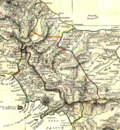 | extinct Indo-European language of southern Italy. The language is in the Osco-Umbrian or Sabellic branch of the Italic languages. Oscan is therefore a... 33 KB (3,966 words) - 05:56, 14 February 2024 |
short inscriptions dating from around 500 BC. The language belongs to the Osco-Umbrian group of languages, and may be closely related to Oscan, but shows... 4 KB (418 words) - 05:44, 28 January 2024 |
 | Etruscan alphabet (category Etruscan language) that it is instead an invention of speakers of a Sabellian language (Osco-Umbrian languages). Its sound value was /f/ and it replaced the Etruscan digraph... 20 KB (981 words) - 15:14, 3 April 2024 |
 | Lydian alphabet (category Lydian language) it is thought to be an invention of speakers of a Sabellian language (Osco-Umbrian languages). In addition, two digraphs, aa and ii, appear to be allophones... 11 KB (690 words) - 16:07, 29 November 2023 |
 | "Volscians and Umbrians." American Journal of Philology 72: 113–27. Wallace, Rex E. 2007. The Sabellic languages of ancient Italy. Languages of the World:... 11 KB (1,233 words) - 02:36, 6 April 2024 |
 | in Osco-Umbrian they become labial p, b. Latin and Faliscan use the ablative suffix -d, seen in med ("me", ablative), which is absent in Osco-Umbrian. In... 8 KB (720 words) - 11:32, 23 March 2024 |
 | *ɣʷ remained distinct from *β in Latin and Venetic, but also merged in Osco-Umbrian. *tl > *kl word-medially. Final *t became *d *l̥, *r̥ > *ol, *or *m̥... 74 KB (4,018 words) - 02:05, 29 March 2024 |
 | Iguvine Tablets (category Osco-Umbrian languages) of any of the Osco-Umbrian group of languages, which are closely related to Latin. The tablets shed light on the grammar of the language, and also on the... 74 KB (9,358 words) - 13:35, 12 February 2024 |
three distinct persons in God Himself Sabellian languages, another name for the Osco-Umbrian languages Sabellians a collective ethnonym for a group of... 447 bytes (98 words) - 11:10, 4 August 2011 |
Gaulish (redirect from Gaulish languages) the Celtic language area, shares with the neighboring Brittonic languages of Britain, as well as the neighboring Italic Osco-Umbrian languages, the change... 87 KB (9,143 words) - 09:10, 23 April 2024 |
 | ⟨Q⟩) (in the so-called P-Celtic languages /kʷ/ developed into /p/; a similar development took place in the Osco-Umbrian branch of Italic and sometimes... 48 KB (5,859 words) - 22:04, 24 April 2024 |
 | Sidicini (category Osco-Umbrian languages) Campanians, and allies of the Ausones and Aurunci. Their language was a part of the Osco-Umbrian linguistic family.[citation needed] According to Strabo... 6 KB (823 words) - 06:42, 27 November 2023 |
 | Patrica (category Articles containing Italian-language text) the surrounding region was inhabited by Italic peoples speaking Osco-Umbrian languages. The Romans called it Patricum. Their presence is attested by aqueduct... 4 KB (338 words) - 15:19, 14 July 2021 |
Paeligni (redirect from Paelignian language) came into conflict in the Second Samnite War, 325 BC. Like other Oscan-Umbrian populations, they were governed by supreme magistrates known as meddixes... 7 KB (898 words) - 22:31, 24 November 2023 |
 | Italians (category CS1 Italian-language sources (it)) Ligurians or Celto-Ligurians. Their language had affinities with both Italic (Latin and the Osco-Umbrian languages) and Celtic (Gaulish). They primarily... 235 KB (21,016 words) - 01:01, 23 April 2024 |
Marrucini (redirect from Marrucinian language) Baldi, ISBN 9783110172089 (Mouton de Gruyter, 1999) Encyclopedia of the Languages of Europe, Edited by: Glanville Price; ISBN 9780631220398 (Wiley-Blackwell... 3 KB (415 words) - 10:11, 13 December 2023 |
 | Hernici (redirect from Hernican language) local characteristic. A couple of inscriptions show that the Hernican language was a member of the Sabellian group. Their name, with its "co" termination... 4 KB (438 words) - 22:51, 14 January 2024 |
 | Oscan Tablet (category Osco-Umbrian languages) one of the most important inscriptions extant in the long extinct Oscan language. This small bronze tablet, attached to an iron chain, was discovered at... 2 KB (260 words) - 10:13, 28 March 2024 |
Cippus Abellanus (category Osco-Umbrian languages) is a stone slab inscribed in the Oscan language. It is one of the most important examples of the Oscan language along with the Tabula Bantina. The Cippus... 4 KB (516 words) - 15:29, 31 March 2024 |
language contact between those two groups. Further, the Italic languages had a similar divergence between Latino-Faliscan, which kept /kʷ/, and Osco-Umbrian... 24 KB (2,421 words) - 01:33, 10 April 2024 |





